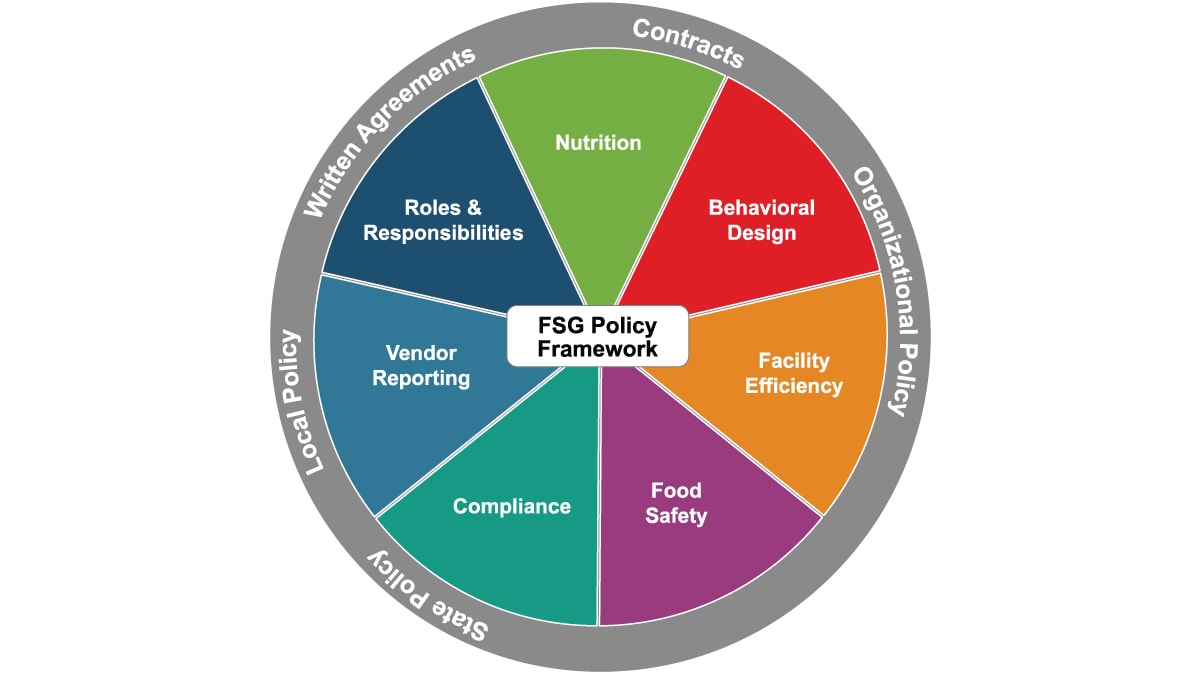At a glance
Putting your food service guidelines into organizational policies can increase the availability and selection of healthier foods and beverages. See links to sample language for contracts and the core components of a comprehensive food service guidelines policy.

Background
An organization's policies and practices can make it easier for people to adopt healthy behaviors. Internal policies can reinforce a culture of health and support healthy eating and physical activity.
These policies may increase worker productivity, improve employee morale, and generate cost savings associated with better employee health outcomes. They may also help your facility operate more efficiently.
Adding nutrition standards and behavioral design requirements to your organizational policies can make healthier foods and beverages more available and easier for people to choose. For example, large employers can update their contracts with onsite vendors to require healthier menu options. They can also require that healthier items be placed at eye level, promoted with innovative marketing techniques, and priced competitively.
You can include food service guidelines standards and behavioral design strategies in a variety of organizational policies, such as:
- Workplace wellness programs and policies.
- Requests for Bids or Requests for Proposals.
- Contract stipulations and Scope of Work requirements.
- Vending permits.
- Bulk food purchasing agreements.
In addition, some local and state ordinances, laws, and executive orders require government worksites follow healthier food service guidelines.
Policy framework
CDC's Food Service Guidelines (FSG) Policy Framework defines seven core components of a comprehensive food service guidelines policy. Food service guidelines policies can include a variety of formal written agreements that prioritize good nutrition and health within any food service operation.

Component descriptions
Nutrition
The nutrition standards that vendors are expected to meet should be clearly stated in the food service guidelines policy or written agreement. They should be based on the most current nutrition science and appropriate for a food service environment. Clear standards allow a vendor to properly plan, purchase, and prepare heathier menu offerings in a timely and cost-effective manner. Sample language for nutrition contracts covers prepared foods, packaged snacks, and beverages.
Behavioral design
These promotional strategies use pricing, placement, and marketing to increase the purchase and consumption of healthier menu offerings. Using any combination of these standards may help vendors launch healthier food services at your organization. These strategies may also increase chances of remaining financially sustainable over time. See sample language.
Behavioral design strategies use pricing, placement, and marketing to increase the purchase and consumption of healthier menu offerings. The Food Service Guidelines for Federal Facilities provides behavioral design standards organized into six categories. Using any combination of these standards may help vendors provide healthier food services that are financially sustainable over time. See sample language.
Facility efficiency
Including facility efficiency standards in food service guidelines policies may reduce a building’s overall environmental impact. Following these standards may improve energy efficiency, help conserve natural resources, and reduce food waste at onsite food service venues. These standards can also support the surrounding community through local sourcing of produce and products from regional growers and food manufacturers. See sample language for food purchasing, waste diversion, and food service management and consumer engagement.
Food safety
Including specific food safety standards in food service guideline policies can help ensure that all onsite food vendors follow applicable state, local, and tribal food safety regulations. These standards can be based on the U.S. Food and Drug Administration's Food Code, which is a model for food handling best practices. You can also use the standards outlined in the Food Service Guidelines for Federal Facilities. These standards go further than the Food Code and address managerial practices, employee behaviors, and food preparation practices.
Food safety standards are designed to reduce the risk of foodborne illnesses and outbreaks that are sometimes common in food service operations. See sample language for Food Code adherence, certified food protection managers, and other food safety considerations.
Compliance
A successful partnership with a food vendor requires collaboration and ongoing monitoring. Including compliance checks in your policy, contract, or written agreement establishes a systematic way to assess whether a vendor is meeting your requirements.
A schedule of routine compliance checks should be established with the vendor upfront. You may also want to consider setting up periodic food environment audits to assess the vendor’s adherence in real time. Compliance checks and audits give vendors an opportunity to identify any challenges or barriers and improve their efforts through mutually agreed-upon changes. See sample language.
Vendor reporting
The specific data or metrics you want the vendor to report should be clearly defined in your healthier food service policy, contract, or written agreement. Clear reporting requirements will help vendors understand what will be assessed over time. Standardized metrics will also help you communicate the impact of your healthier food service initiative.
Vendor reports can be used for more than demonstrating compliance. They generally contain information about overall operations, trainings, food service staff, gross sales and profit margins, and comparisons between sales of healthy and less healthy foods. They can also provide metrics to help you evaluate the overall impact—positive or negative—of your organization's food service guidelines. This information can then be shared with your organization's leadership, partners, and champions. See sample language.
Roles and responsibilities
Your food service guidelines policy should clearly identify who is responsible for carrying out the specific activities and objectives of the policy. These activities include, for example, implementing your healthier food service initiative and monitoring and evaluating the policy’s impact. See sample language.
Putting policies into practice
These short videos describe effective food service guidelines policies and how to put them into practice in your community. They were created by the National Association of County and City Health Officials and CDC's Division of Nutrition, Physical Activity, and Obesity.
Next steps
Return to "Building Blocks"
Use the "Building Blocks of Food Service Guidelines" to navigate to other parts of the Food Service Guidelines Implementation Toolkit.





